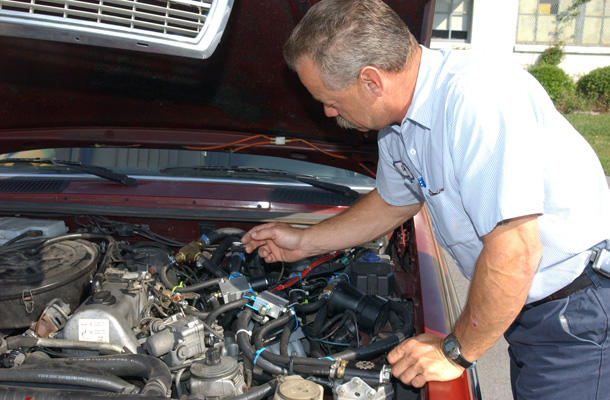Whether or not you can adjust or replace a belt yourself depends on the type of belt(s) you have.
On most modern vehicles, a single, long, flat belt called a serpentine multiaccessory drive belt (see Figure 12-11) drives all the engine accessories. This belt winds its way around every accessory pulley, and on the way winds tightly around a "tensioner" pulley that keeps the belt at the correct tension. In cases where it's possible to adjust the tensioner, you usually find a set of marks on the tensioner assembly that indicates the correct tension.
Tip: There are very few older vehicles still on the road that have an accessory belt that only drives one component. If your car has this setup, you can check the belt to see whether it has more than 1⁄2 inch of "play" and needs to be adjusted; or is cracked, frayed, or otherwise in need of replacement.
Tip: It isn't easy to figure out whether a belt is at the right tension just by looking at it, and often it's obscured by a shield or cowling. If the belt is loose, you'll hear squeaky noises when you accelerate sharply. With the hood up, the gearshift in Park or Neutral, and the parking brake on, have a friend accelerate the engine while you listen. Be sure to keep your hair and clothing away from the belt.

Caution: Because tensioners are spring-loaded, they can be unsafe to deal with yourself. Check your owner's manual or a service manual for your vehicle's make, model, and year to see what's involved in adjusting your accessory belt. If you can't reach the adjusting mechanism without removing other parts, if adjusting the belt requires special tools, or if it looks as though releasing thetension may be risky, you should have a professional deal with it.
If the belt squeaks, it may have been contaminated by water, coolant, oil, or another fluid. If it's just water, check around the water pump and the hoses to see where the leak is, and eliminate the cause of the leak. The water will dry up on its own. The belt needs to be replaced if the contaminant is coolant, oil, power-steering fluid, or some other substance or if the belt has broken, is frayed, or has large cracks or pieces missing.
Car Smarts: If a belt needs to be replaced and you're dealing with a shop you know and trust, ask them to check the tensioner. Replacing a tensioner may be costly, so if it looks as though it may need to be replaced soon, you can avoid having to pay again for the time and labor to access it by having both jobs done at once.
From Auto Repair for Dummies, copyright © 2009 by Wiley Publishing, Inc., Indianapolis, Indiana. Used by arrangement with John Wiley & Sons, Inc.










